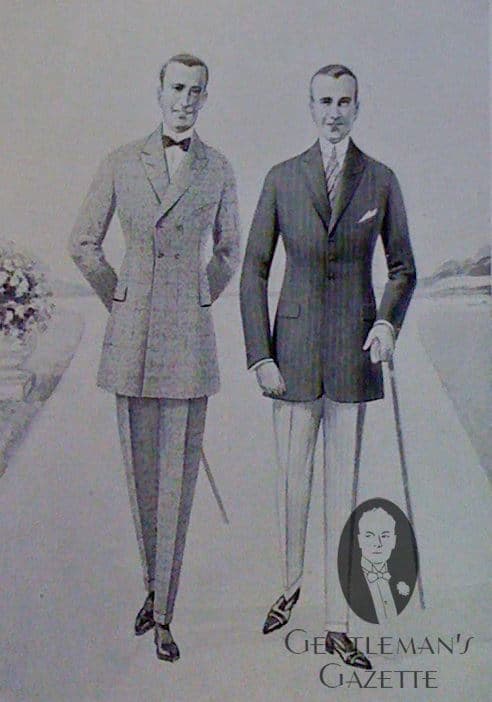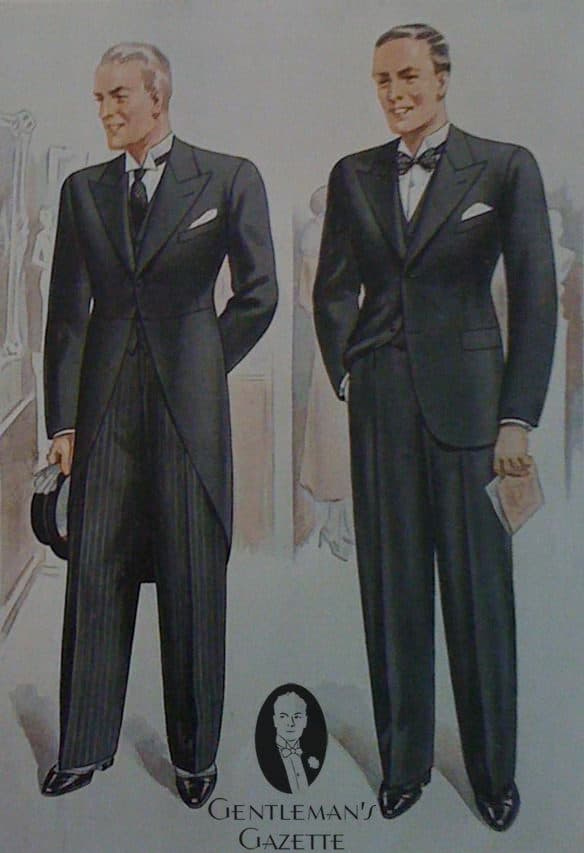If you are a regular reader of the Gentleman’s Gazette, you probably know that I am an avid collector of vintage men’s fashion magazines.

Not only are the illustrations of Apparel Arts, Esquire, Monsieur, Cutter & Tailor, Arbiter, Herrenjournal etc. outstanding, but the information contained therein is so much more comprehensive than anything we enjoy from Flusser, Rotzel et al. nowadays. In fact, when you compare the information and attention to detail in these volumes to what is available today, modern day authors look like amateurs. Therefore I have made an effort in the last 4 years to collect and digitize as many magazines as I can to make them available to the men of today. In the process, I regularly discover previously unknown publications (to me) across new men’s fashion publications from the past. While there are often unexceptional, I find a few gems every now and then. Online, there seems to be a heavy imbalance between English and American men’s fashion magazines and those from other countries. Personally, I am a native German speaker and so it is easy for me to read and find new German magazines, but I am certain there are more treasures in Spanish, Dutch, Russian, Portuguese, Italian… we just have to find them! So if you ever come across any of these vintage magazines, let me know.

Der Herr – Men’s Fashion from 1913 to 1943
Today, I want to introduce you to the magazine Der Herr – meaning The Gentleman, which is probably one of the earliest magazines of its kind with the first issue being released in 1913 at the Rudolf Maurer Verlag Berlin! Just for comparison sake, Esquire was not issued until 1933, Apparel Arts debuted in 1931, Herrenjournal and Arbiter in 1927, Monsieur in 1920. Only the Tailor & Cutter had its inception earlier than 1869, however unlike der Herr, which was directed at consumers, the Tailor & Cutter was a trade publication for bespoke tailors that dabbled in consumer questions of style and fashion. The editorial team of Der Herr was spearheaded by Hubert Miketta, who – together with Baron von Eelking – set the tone of German men’s fashion for more than half a century. Unlike the Herrenjournal, in which Eelking published all the fashion editorials for the first few years, Miketta had hired authors from the get go, although he would also contribute articles himself. Despite WWI, Der Herr was published from 1913 throughout 1943, when the Total War required every non-propaganda publication in Germany to cease its operation. Due to the two world wars, and the fact that the target market was never very large, issues of Der Herr are rare though very insightful about the fashion intricacies at the time.
Der Herr in the 1920s

So far, the earliest edition I have seen is from 1921. I really enjoyed reading the very first issue because it is so very different from the magazines at the end of the decade. At that time, an issue usually consisted of just 12 – 20 pages, whereas fashion magazines in the 1930’s could sometimes have more than 100. However, since there were no placed advertisements in these early editions, they provide a good overview of the period fashions. First of all, the cover of the magazine always showed a gentleman lounging in a club chair with a lounge suit, cigarette, spats and an issue of Der Herr. Once you flip through the first few pages, you see the distinctly 1920’s silhouette of body coats, such as the frock coat and the newly popularized morning coat. Unlike in the 1930’s, the shoulders are very fitted, the trousers are cut slim and there is no drape in the chest. Just look at this picture of the two gentleman. The waist is very fitted, and the two-button coat on the right has the lower button on the waistline, just like the Paddock coat, the chest pocket is very angled, the lapels are slim and the shoes are pointed. Of course, both of them walk with their cane, which was purely decorative, and almost obligatory for a member of the gentry. The gentleman on the left wears a 4×2 frock coat; even in the 1920’s frock coats were already long past their peak. Interestingly, overcoats were cut much wider back then, despite the rather narrow fitting suits. The articles in the magazine are rather short and rarely extend to 3 pages, but as the authors expressed, just a few years before there were no gentlemen left. They were either soldiers or a men, but not gentleman. Now that the war was over, men in Germany once again returned to dress culture. Of course, they look to other countries and cities such as Hyde Park in London, the Côte d’Azur or Fifth Avenue in NYC. They also talked about travel outfits, which for a while no one could pursue such leisurely activities. The following group illustration gives us a good overview of the fashions of the day in Germany.

Der Herr in the 1930’s

In the 1930’s Artur Rey was the head of the editorial team and the covers now changed with every issue. While the content of the 1920’s issues was always in black and white text and illustrations, you can find more illustrations in color as well as black and white photograph in the thirties. With the change in men’s fashion, in England and the US, the suits in Germany changed as well. The illustrations now clearly show the trend of wider yet rounder shoulders, drape in the chest, full cut trousers and more fitted overcoats.

Here, we see two gentlemen in morning coat and dark suit. If you compare this illustrations of British or American illustrations, you would not see a difference in style and cut. The lapels have a lower gorge but are not as slim as they were in the twenties; both wear high detachable wing collars, there is drape in the chest, the trousers are almost twice as wide, thought the chest pocket is still angled and the shoes sill rather pointy.
Fashions in the US
One of the articles was about Mode in den USA, or Fashion in the USA, and I thought it was quite funny to see what they outlined. First, we have a golf outfit on the very left as worn by William Bakewell, with a brown velour suede

leather windbreaker jacket with large patch pockets and the newly introduced zippers with knickerbockers in tweed. In the middle, we see actor Richard Alen in a brown Polo coat and on the right a gent in proper morning dress. He wears a double breasted gray waistcoat, spats and black bow tie with cane and gloves. The author describes this outfit as the Besuchsanzug – a suit that Americans wear to visit others. Of course, this is way more formal that what the general American wore in the thirties. These pictures were from Paramount and Metro-Goldwyn Meyer and so these silver screen stars were considered to stand for Americans in general.


Conclusion
Overall, der Herr was a fabulous menswear publication from the early days of this medium, that informed German gentleman about the latest fashion trends and etiquette in regard to clothing without branching out in other areas of lifestyle. As such, its circulation was smaller than the Herrenjournal but it nevertheless existed for 30 years, before WWII would put an end to this valuable little magazine. Today, it is a valuable resource to trace the development of fashion in Germany and the influences from abroad. If you ever come across an issue of Der Herr, or any other men’s fashion magazine from that time, please send me an email, thanks!

What a a great find and treasure trove of images and info from the time. I think you are right, there are probably a lot of still undiscovered small magazines in other languages – I hope at least!
R
Absolutely, keep your eyes open!
impressive and very valuable info on tracing back the men’s style dated back starting with this little bible.
Again, very nice and interesting illustrations.
Looking at the bottom one showing evening wear, I see a man wearing what looks more like what I’d have thought of as day wear. The top two (smaller) figures are wearing summer dinner jackets and, as best I can follow in my schoolboy german, the main dinner jacket is something called Porotwist – which an internet search suggests was a lightweight make in the 30s. Is this german summer evening wear, much like the blue jacket and white trouser look that was acceptable evening wear in the US?
As best I can work out the text tells us that the Ascot tie/Plastron brings a festive society air to outfit in combination with his natty waistcoat.
Hal, I translated it for you:
————
Top left:
Light fleece coat in raglan cut as overcoat for summer evening dress.
Coloured silver-grey or beige, with wide collar and lapels. The coat exhibits a pleasant width.
Top right:
Model of the mess dress jacket further explained in the text, which looks extraordinarily comfortable, elegant, debonaire and decorative.
LEFT man on right picture:
Typical form of a summer dinner jacket made from material previous to air.
The lapels are peaked and in matté silk. The quartes are curved moderatly.
RIGHT man on right picture:
Elegantly looking version of evening (sic!) dress made from fine self-patterned Porotwist.
The black plastron has a festive, formal note in combination with the light double-breasted waistcoat, which has broadened lapels and collar.
———–
All in all, nice article as usual! Although I am quite astonished about the last evening attire … I had immediately put that into the morning dress category …
Thanks for the translation. And glad to see I wasn’t the only one who thought it unusual evening wear.
Hal and Marcus,
Always bear in mind that communication back then was much slower, and so sometimes people would wear things outside of Britain in a different manner. For example, I do have a German book from 1923 that suggests to wear a morning coat for evening wear!!! This was a new garment and people not always understood its origins. A few years later, it was only appropriate for daywear of course. I think with this picture, it is the same way. A plastron and lighter colored waistcoat are something that we associate with morning wear nowadays.
Always has been interesting to see the illustration from your collection,Those cloth are classics yet wearable today. Thanks Sven,and not forgetting Marcus for the translation.
murtadza
You are welcome Ismail.
Hope to see the illustration from the Italian fashion book
murtadza
Although I live in the US I have over the years seen illustrations from Der Herr…..they are quite magnificent perhaps reflecting German excellence in graphic arts during this period.
I am pretty sure you have not seen Der Herr in the US, maybe from das Herrenjournal?
Interesting to note the gentleman in the second cover. I always remove the glove on my cigarette hand as the smoke reacts wit the leather.
Back then, gentlemen had numerous unlined gloves and they were washed on a regular basis. Today, that would be quite costly, I suppose. How exactly does the leather react in your experience?